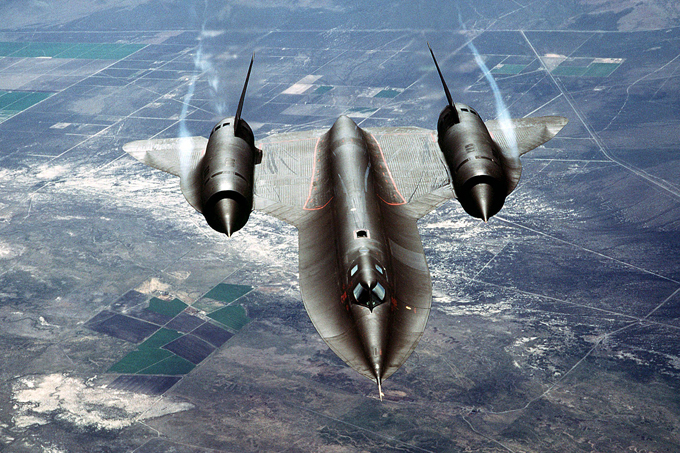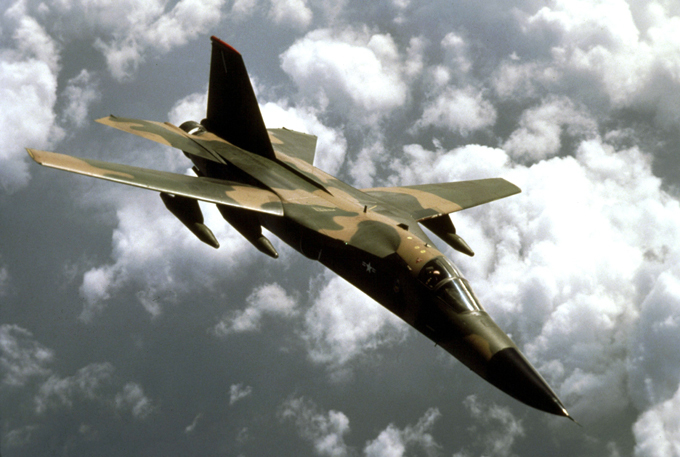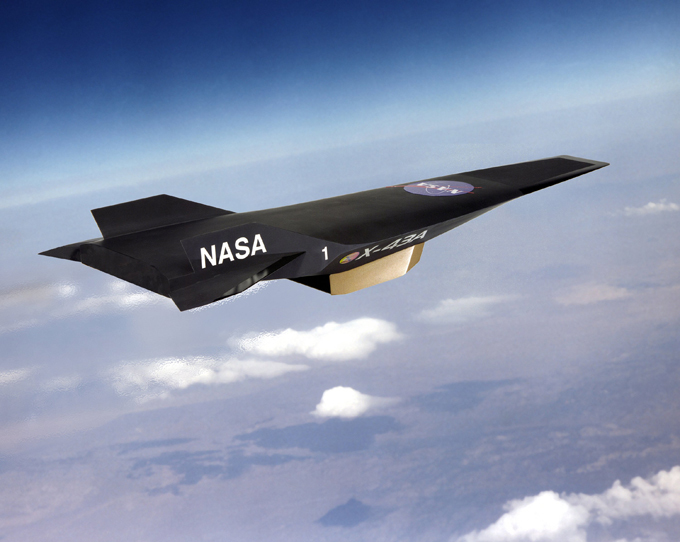Fastest aircraft built by man

Lockheed SR-71 is a long-range, Mach 3+ strategic reconnaissance aircraft that was operated by the United States Air Force. It was developed as a black project from the Lockheed A-12 reconnaissance aircraft in the 1960s by Lockheed and its Skunk Works division. Renowned American aerospace engineer Clarence "Kelly" Johnson was responsible for many of the design's innovative concepts. During aerial reconnaissance missions, the SR-71 operated at high speeds and altitudes to allow it to outrace threats. If a surface-to-air missile launch was detected, the standard evasive action was simply to accelerate and outfly the missile. The SR-71 was designed to have basic stealth characteristics and served as a precursor to future stealth aircraft
Lockheed SR-71 is a long-range, Mach 3+ strategic reconnaissance aircraft that was operated by the United States Air Force. It was developed as a black project from the Lockheed A-12 reconnaissance aircraft in the 1960s by Lockheed and its Skunk Works division. Renowned American aerospace engineer Clarence "Kelly" Johnson was responsible for many of the design's innovative concepts. During aerial reconnaissance missions, the SR-71 operated at high speeds and altitudes to allow it to outrace threats. If a surface-to-air missile launch was detected, the standard evasive action was simply to accelerate and outfly the missile. The SR-71 was designed to have basic stealth characteristics and served as a precursor to future stealth aircraft

The McDonnell Douglas (now Boeing) F-15 Eagle is an American twin-engine, all-weather tactical fighter designed by McDonnell Douglas to gain and maintain air superiority in aerial combat. It is among the most successful modern fighters, with over 100 victories and no losses in aerial combat. Following reviews of proposals, the United States Air Force selected McDonnell Douglas' design in 1967 to meet the service's need for a dedicated air superiority fighter. The Eagle first flew in July 1972, and entered service in 1976.
The McDonnell Douglas (now Boeing) F-15 Eagle is an American twin-engine, all-weather tactical fighter designed by McDonnell Douglas to gain and maintain air superiority in aerial combat. It is among the most successful modern fighters, with over 100 victories and no losses in aerial combat. Following reviews of proposals, the United States Air Force selected McDonnell Douglas' design in 1967 to meet the service's need for a dedicated air superiority fighter. The Eagle first flew in July 1972, and entered service in 1976.

The General Dynamics F-111 Aardvark was a supersonic, medium-range interdictor and tactical Attack aircraft that also filled the roles of strategic bomber, aerial reconnaissance, and electronic-warfare aircraft in its various versions. Developed in the 1960s by General Dynamics, it first entered service in 1967 with the United States Air Force. The Royal Australian Air Force (RAAF) also ordered the type and began operating F-111Cs in 1973
The General Dynamics F-111 Aardvark was a supersonic, medium-range interdictor and tactical Attack aircraft that also filled the roles of strategic bomber, aerial reconnaissance, and electronic-warfare aircraft in its various versions. Developed in the 1960s by General Dynamics, it first entered service in 1967 with the United States Air Force. The Royal Australian Air Force (RAAF) also ordered the type and began operating F-111Cs in 1973

The X-43 was an unmanned experimental hypersonic aircraft with multiple planned scale variations meant to test various aspects of hypersonic flight. It was part of the X-plane series and specifically of NASA's Hyper-X program. It set several airspeed records for jet-propelled aircraft. The X-43 is the fastest aircraft on record at approximately 7,000 miles per hour (11,000 km/h). A winged booster rocket with the X-43 placed on top, called a "stack", was drop launched from a larger carrier plane. After the booster rocket (a modified first stage of the Pegasus rocket) brought the stack to the target speed and altitude, it was discarded, and the X-43 flew free using its own engine, a scramjet.
The X-43 was an unmanned experimental hypersonic aircraft with multiple planned scale variations meant to test various aspects of hypersonic flight. It was part of the X-plane series and specifically of NASA's Hyper-X program. It set several airspeed records for jet-propelled aircraft. The X-43 is the fastest aircraft on record at approximately 7,000 miles per hour (11,000 km/h). A winged booster rocket with the X-43 placed on top, called a "stack", was drop launched from a larger carrier plane. After the booster rocket (a modified first stage of the Pegasus rocket) brought the stack to the target speed and altitude, it was discarded, and the X-43 flew free using its own engine, a scramjet.

The Grumman F-14 Tomcat is a supersonic, twin-engine, two-seat, variable-sweep wing fighter aircraft. The Tomcat was developed for the United States Navy's Naval Fighter Experimental (VFX) program following the collapse of the F-111B project. The F-14 was the first of the American teen-series fighters, which were designed incorporating the experience of air combat against MiG fighters during the Vietnam War.
The Grumman F-14 Tomcat is a supersonic, twin-engine, two-seat, variable-sweep wing fighter aircraft. The Tomcat was developed for the United States Navy's Naval Fighter Experimental (VFX) program following the collapse of the F-111B project. The F-14 was the first of the American teen-series fighters, which were designed incorporating the experience of air combat against MiG fighters during the Vietnam War.

The Sukhoi Su-27 (Russian: Сухой Су-27) (NATO reporting name: Flanker) is a twin-engine supermaneuverable fighter aircraft designed by Sukhoi. It was intended as a direct competitor for the large United States fourth-generation fighters such as the F-14 Tomcat and F-15 Eagle, with 3,530-kilometre (1,910 nmi) range, heavy aircraft ordnance, sophisticated avionics and high manoeuvrability. The Su-27 most often flies air supremacy missions, but its most modern variants are able to perform almost all aerial warfare operations. Complementing the smaller MiG-29, the Su-27 has its closest US counterpart in the F-15 Eagle.
The Sukhoi Su-27 (Russian: Сухой Су-27) (NATO reporting name: Flanker) is a twin-engine supermaneuverable fighter aircraft designed by Sukhoi. It was intended as a direct competitor for the large United States fourth-generation fighters such as the F-14 Tomcat and F-15 Eagle, with 3,530-kilometre (1,910 nmi) range, heavy aircraft ordnance, sophisticated avionics and high manoeuvrability. The Su-27 most often flies air supremacy missions, but its most modern variants are able to perform almost all aerial warfare operations. Complementing the smaller MiG-29, the Su-27 has its closest US counterpart in the F-15 Eagle.

The North American X-15 was a hypersonic rocket-powered aircraft operated by the United States Air Force and the National Aeronautics and Space Administration as part of the X-plane series of experimental aircraft. The X-15 set speed and altitude records in the 1960s, reaching the edge of outer space and returning with valuable data used in aircraft and spacecraft design. As of September 2015, the X-15 holds the official world record for the highest speed ever reached by a manned, powered aircraft. Its maximum speed was 4,520 miles per hour (7,274 km/h), or Mach 6.72
The North American X-15 was a hypersonic rocket-powered aircraft operated by the United States Air Force and the National Aeronautics and Space Administration as part of the X-plane series of experimental aircraft. The X-15 set speed and altitude records in the 1960s, reaching the edge of outer space and returning with valuable data used in aircraft and spacecraft design. As of September 2015, the X-15 holds the official world record for the highest speed ever reached by a manned, powered aircraft. Its maximum speed was 4,520 miles per hour (7,274 km/h), or Mach 6.72

Сверхзвуковой истребитель-перехватчик "МиГ-25" состоял на вооружении ВВС СССР и сейчас находится на вооружении ВВС РФ. Производился с 1969-го по 1985 год. Максимальная скорость - 3000 километров в час. 6 сентября 1976 года "МиГ-25" был угнан советским летчиком в Японию. Самолет вернули, но перед этим его разобрали до винтика. Все стоявшие на вооружении самолеты модернизировали и обозначили "МиГ-25ПДС".
Сверхзвуковой истребитель-перехватчик "МиГ-25" состоял на вооружении ВВС СССР и сейчас находится на вооружении ВВС РФ. Производился с 1969-го по 1985 год. Максимальная скорость - 3000 километров в час. 6 сентября 1976 года "МиГ-25" был угнан советским летчиком в Японию. Самолет вернули, но перед этим его разобрали до винтика. Все стоявшие на вооружении самолеты модернизировали и обозначили "МиГ-25ПДС".

"МиГ-31" (по кодификации НАТО: Foxhound - лисья гончая) - двухместный сверхзвуковой всепогодный истребитель-перехватчик дальнего радиуса действия. Разработан в ОКБ-155 (ныне ОАО «РСК „МиГ"»), производился с 1975-го по 1994 год. Максимальная скорость - 3000 километров в час.
"МиГ-31" (по кодификации НАТО: Foxhound - лисья гончая) - двухместный сверхзвуковой всепогодный истребитель-перехватчик дальнего радиуса действия. Разработан в ОКБ-155 (ныне ОАО «РСК „МиГ"»), производился с 1975-го по 1994 год. Максимальная скорость - 3000 километров в час.



